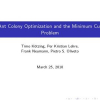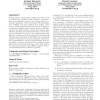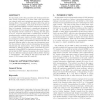106
Voted
GECCO
2010
Springer
15 years 5 months ago
2010
Springer
The Hypercube-based NeuroEvolution of Augmenting Topologies (HyperNEAT) approach demonstrated that the pattern of weights across the connectivity of an artificial neural network ...
109
Voted
GECCO
2010
Springer
15 years 5 months ago
2010
Springer
This paper presents a novel approach for knowledge mining from a sparse and repeated measures dataset. Genetic programming based symbolic regression is employed to generate multip...
71
Voted
GECCO
2010
Springer
15 years 5 months ago
2010
Springer
103
click to vote
GECCO
2010
Springer
15 years 5 months ago
2010
Springer
Niching schemes, which sustain population diversity and let an evolutionary population avoid premature convergence, have been extensively studied in the research field of evoluti...
GECCO
2010
Springer
15 years 5 months ago
2010
Springer
HyperNEAT represents a class of neuroevolutionary algorithms that captures some of the power of natural development with a ionally efficient high-level abstraction of development....
120
Voted
GECCO
2010
Springer
15 years 5 months ago
2010
Springer
An important goal for the generative and developmental systems (GDS) community is to show that GDS approaches can compete with more mainstream approaches in machine learning (ML)....
GECCO
2010
Springer
15 years 5 months ago
2010
Springer
Abstract. We discuss the problem of model selection in Genetic Programming using the framework provided by Statistical Learning Theory, i.e. Vapnik-Chervonenkis theory (VC). We pre...
112
Voted
GECCO
2010
Springer
15 years 5 months ago
2010
Springer
In order to allow a comparison of (otherwise incomparable) sets, many evolutionary multiobjective optimizers use indicator functions to guide the search and to evaluate the perfor...
101
Voted
GECCO
2010
Springer
15 years 5 months ago
2010
Springer
This paper describes a study of the evolution of distributed behavior, specifically the control of agents in a mobile ad hoc network, using neuroevolution. In neuroevolution, a p...
68
Voted
GECCO
2010
Springer
15 years 5 months ago
2010
Springer





